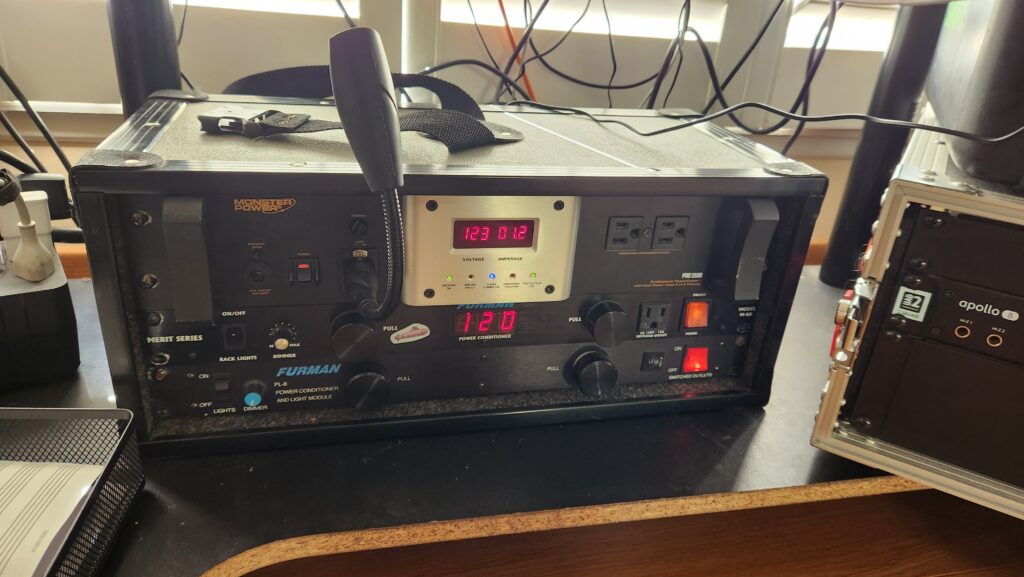Let’s Talk About Power
I just set up a better power distribution and conditioning system for my home studio, and on the first run with everything plugged into the new system I was kicking myself for not doing this YEARS ago. Everything sounded so much cleaner and clearer, and I already use pretty high end gear.
If you’re recording or mixing sound, paying attention to what is powering your devices—whether it’s a power strip from Home Depot or a $4000 toroidal transformer that weighs 95 pounds—is an easy way to make your home recordings and mixes sound better, and to protect your expensive gear. My mentor used to say that in recording, the electricity you’re using is everything. Let’s talk about why, and then look at a couple of potential solutions.
How Electricity Works In A Recording Setup
When you sing or play an instrument into a microphone, the sound waves you’re making jiggle a little piece of metal called a diaphragm. That piece of metal’s jiggling induces a current in a cable. This process is called transduction, which just means “changing medium.” A microphone transduces air waves into electrical waves. Different types of mics do this in different ways, but we’re not gonna worry about that for today.
We call these electrical waves analog signal. They are analog because they are not discrete voltages but a continuous change. Digital signal, on the other hand, is the stream of 1s and 0s that a computer can deal with. ADCs and DACs convert signal from analog to digital and back, and for most people will be just a built in function of their interfaces. ADC stands for analog-digital converter. Can you guess what DAC stands for?
Once we’ve got signal of any sort, we can easily control and manipulate it, most often by plugging cables into different pieces of gear. Want a sound to be louder? Maybe try cranking up the gain on a preamp you like. Want to stick a cool delay pedal on your guitar? Cool, plug a cable in, analog signal goes right through. Would you rather use an effect plug-in in your DAW? Great, just route the digital signal through it. Go wild!
Why To Buy A Power Conditioner
Now, think about the fact that we’ve described analog signal as an electrical wave or a continuously changing voltage, and think about where 99% of us get our electricity: some wall outlet close to our desk.
The devices we are plugging in are using that wall power to do whatever they do to our analog signal. If the amount of power coming out of the wall is wavering up and down (which it is, because your house almost certainly doesn’t have audio filtering built into it unless you’re Paul Massey or something), we’re introducing distortion to the signal, which translates to noise in the sound. It’s usually subtle, but when it’s multiplied by every piece of gear you plug in on every track you record, the net result is that your music sounds less good.
That’s not so cool, especially when improving your sound is pretty easy by upgrading a few things about your power situation.
What To Do (take the power back)
Okay, first off, if you’ve got an audio device plugged straight into a wall outlet, stop that right now. Go get a $10 surge protector from CVS to keep your gear from getting destroyed. That is upgrade #1, and do that ASAP. Also make sure none of your power cables are shredded, that the heads aren’t damaged, stuff like that. If they are, replace them. That is way cheaper than dying. Do you know how much a funeral costs?
Alright, now that that’s out of the way, there are three things we are looking for in our power situation: protection, consistency, and isolation. Let’s look at each:
Protection
Protection is easy. Even cheap power strips offer this. When your house gets hit by a power surge, it trips a thing inside—I’m pretty sure this is called a circuit breaker—to disconnect your gear from the wall, thus protecting it from the wave of electronic death coming down the cable. It causes your gear to suddenly turn off, but that’s better than blowing it up.
If you’ve already got a fancy power setup and are just looking to add a couple more plugs, you can just get a cheap/simple power strip like this and plug it into your fancy conditioner. Just make sure you’re not overloading the amperage. If you want one with a long cable (useful for live shows), this thing from Furman seems to make people happy.
Consistency
The next step up in things that will actually make your music sound better is consistency. If the voltage isn’t jumping up and down, there’s less distortion. Simple. This is where power conditioners come into play.
A power conditioner levels out the signal coming from the wall, so that your devices are doing what they’re supposed to be doing to the sound, and nothing else. I think of these as “fancy power strips,” because while they do improve your situation, they don’t quite have pro audio level filtering.
Power conditioners like the Furman Merit Series are fine for this. Furman isn’t paying me, they just make a bunch of different models and it’s not worth overthinking things. The Radial Power series looks good as well. We’re now into spending $100 territory though. Which, frankly, is territory I don’t like. Cheap stuff is cool (like the surge protector above). But if you’re legit down for saving up a hundred bucks to sound a little better, save up $100 more to sound a lot better. This brings us to…
Isolation
Great song. One time I saw Moby sing it with Peter Hook and The Light. Cool.
Okay, but electricity! Remember how we said we like it when the power going to our gear is nice and steady? Well, not only can power from the grid be kinda shaky, but all kinds of stuff can interfere with the electricity running through your cables and tubes. Radio frequency noise is one thing (rest your cell phone on a guitar amp and have someone call you, you’ll hear this through the speakers), while other devices on the same circuit can also cause screwiness.
Lights on a dimmer switch are a common offender here, as are big appliances. One time I was at a venue that didn’t have the stage isolated from the bar, and we had a loud buzz in the PA when we plugged an interface into the board. We probably spent twenty minutes hunting for the piece of gear causing it and it turned out to be the refrigerator under the bar.
This is where the real power conditioners come into play, with isolated outlets that also filter out noise. If you’re serious about recording and/or mixing, I would strongly recommend jumping up to the $200-$300 price bracket. Only top level classical recordists need the $1000+ boxes. You will notice an instant improvement to everything you do. Music coming through your speakers will sound better. Hell, YouTube will sound better. Your mixes will print cleaner, and when you drive your gear hard, it’s the gear you’ll hear, not a weirdly-powered version of it.
If you want to get crazy with this you can get into multiple power conditioner situations…we’ll look at that at the end.
Which Power Conditioners To Look At
Okay, so what to buy? For RF rejection, I like these silver (you guessed it) Furman PST-8 strips. I take one with me to shows, and plug my pedalboard/amp/interface in, and it sounds solid. For my desk rack unit, I’ve got a Monster Power Pro-3500. It was about $300, but that’s an older model. Looks like the Pro-5100 is on Reverb for around $500. It not only isolates you from RF and the rest of your house, but has circuits isolated from each other on it. The new Black Lion Audio PG-1 and PG-2 ($300 and $400) look real cool. I’ve used other Black Lion Audio gear and it always sounds awesome, so for being readily available (whereas the Monster might take some hunting), I’d probably now just get one of these.
For pedalboards, just get a Voodoo Labs one already. Although the True Tone 1-Spot Pro CS 12 is awesome, if you need twelve plugs.
Getting Into Pro Territory – Not All That Hard
Alright, here’s a picture of the power setup under my desk. I’m indulging myself here.

Now, remember how we made the distinction earlier between analog and digital signal, with analog being sound and digital being 1s and 0s? And then we said isolation is good? If you want to get real crazy, use separate power conditioners for your analog and digital gear. Wondering which is which? Anything that touches an analog signal, anywhere, is considered analog for these purposes. So, your interface, while a digital device, has an ADC and DAC in it. It goes on the analog conditioner. So do your speakers, and any preamps, pedals, or other outboard gear that will touch signal. Your laptop and MIDI controller, which are only dealing with 1s and 0s, goes onto the digital conditioner. Now we’ve got an extra layer of isolation for the analog signal. Plus the conditioner for the digital stuff can be cheaper – you don’t need RF filtering for computer processors.
Some of the fancier power conditioners out there get into stepped, or delayed, power up and power down cycles. The Black Lion ones I mentioned do. This just means that there is a time delay between circuits. This is to keep from sending a pop through your speakers. You plug your interface to circuit 1, your speakers to circuit 2, and then when circuit 2 turns on a few seconds after circuit 1, your interface is already powered up. Opposite order when powering down.
A final thought on using multiple power conditioners: you can divide up your gear into “audio work time” and “wasting time on the internet time” conditioners. This is kind of how my setup works actually. On the cheaper conditioner, for all digital, I’ve got my laptop, hard drives, and computer accessories. On the fancy stepped analog one (which has a digital circuit too), I’ve got my interface, reamp box, speakers, and a control surface. This means when I’m done working I can power down the analog one (which draws 1.2 amps, kind of a lot) and still use my computer normally.
Alright, that was my first blog post in three years. I hope you learned something. Leave a comment if so, or if there’s some audio thing you’d like to hear about for the next one.
Cheers,
Dr. Nick
ADDENDUM: don’t rack a power conditioner next to an interface (or anything with converters in it) because then the conditioner itself can interfere with the conversion. It’s also best to keep power cables and signal cables as far apart as possible.
